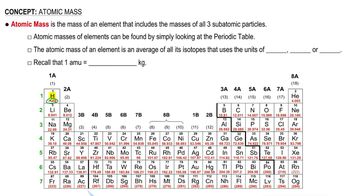Write the correct symbol, with both superscript and subscript, for each of the following. Use the list of elements in the front inside cover as needed: (b) the isotope of krypton with mass number 84 (c) the isotope of rhenium with mass number 187
Ch.2 - Atoms, Molecules, and Ions
Chapter 2, Problem 33a
(a) What isotope is used as the standard in establishing the atomic mass scale?
 Verified step by step guidance
Verified step by step guidance1
Identify the element commonly used as a reference standard for the atomic mass scale.
Recognize that the atomic mass scale is based on the mass of a specific isotope of this element.
Understand that this isotope is chosen because it is stable and abundant, making it a reliable standard.
Note that the atomic mass of this isotope is defined as exactly 12 atomic mass units (amu).
Conclude that the isotope used as the standard in establishing the atomic mass scale is Carbon-12.

Verified video answer for a similar problem:
This video solution was recommended by our tutors as helpful for the problem above.
Video duration:
3mWas this helpful?
Key Concepts
Here are the essential concepts you must grasp in order to answer the question correctly.
Atomic Mass Unit (amu)
The atomic mass unit (amu) is a standard unit of mass used to express atomic and molecular weights. It is defined as one twelfth of the mass of a carbon-12 atom, which is the isotope of carbon with six protons and six neutrons. This unit allows chemists to compare the masses of different atoms and molecules on a relative scale.
Recommended video:
Guided course

Atomic Mass
Isotopes
Isotopes are variants of a particular chemical element that have the same number of protons but different numbers of neutrons. This results in different atomic masses for the isotopes of the same element. For example, carbon has several isotopes, including carbon-12 and carbon-14, with carbon-12 being the standard for the atomic mass scale.
Recommended video:
Guided course

Isotopes
Standard Reference Isotope
The standard reference isotope for establishing the atomic mass scale is carbon-12. By defining the atomic mass of carbon-12 as exactly 12 amu, scientists can calculate the relative atomic masses of all other elements based on their isotopic compositions. This standardization is crucial for consistency in scientific measurements and calculations.
Recommended video:
Guided course

Isotopes
Related Practice
Textbook Question
3
views
Textbook Question
Write the correct symbol, with both superscript and subscript, for each of the following. Use the list of elements in the front inside cover as needed: (d) the isotope of magnesium that has an equal number of protons and neutrons.
3
views
Textbook Question
Without doing any detailed calculations (but using a periodic table to give atomic weights), rank the following samples in order of increasing numbers of atoms: 0.2 mol PCl5 molecules, 80 g Fe2O3, 3.0 3 1023 CO molecules.
1
views
Textbook Question
(b) The atomic weight of boron is reported as 10.81, yet no atom of boron has the mass of 10.81 u. Explain.
Textbook Question
(a) What is the mass in u of a carbon-12 atom?
Textbook Question
(b) Why is the atomic weight of carbon reported as 12.011 in the table of elements and the periodic table in the front inside cover of this text?
1
views
